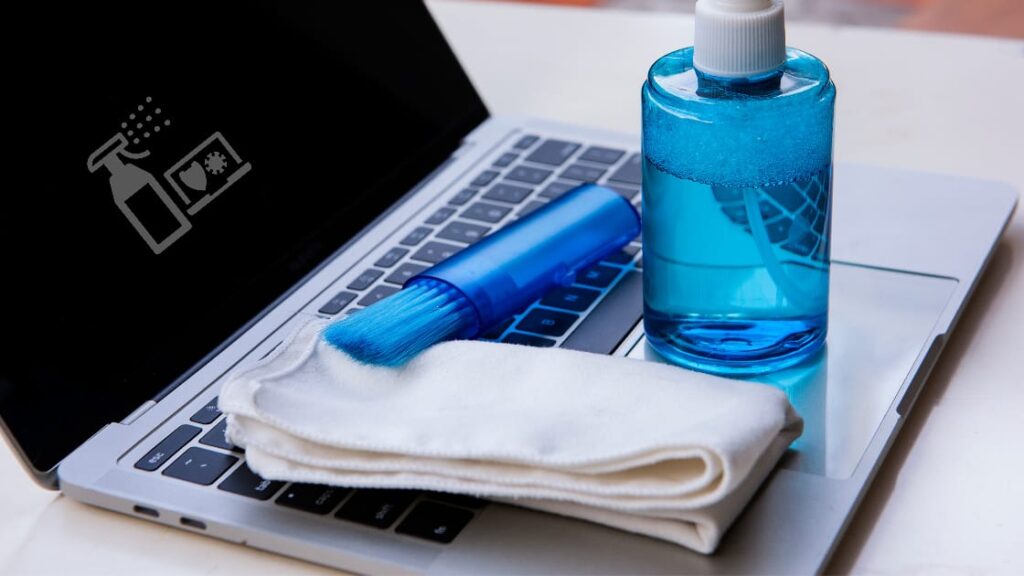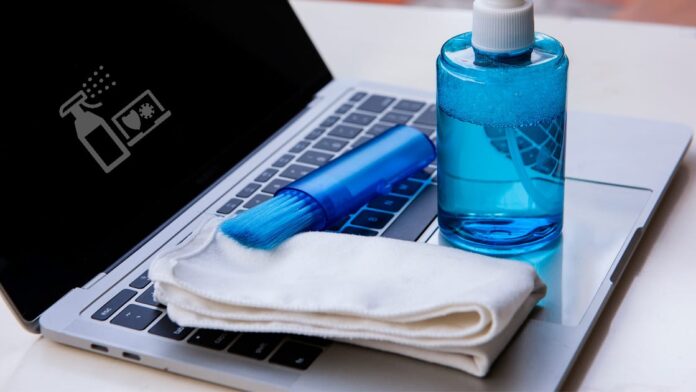Table of Contents
Laptop Cleaning Kit
In today’s fast-paced digital world, laptops are vital device for communication, business, and relaxation. However, with frequent use comes the accumulation of dust, dirt, and grime, which can not only affect the appearance but also the performance and longevity of your device. That’s where a reliable laptop cleaning kit comes in handy.
A laptop cleaning kit typically consists of several essential components designed to effectively remove dirt and maintain your device in pristine condition. Let’s delve into the key components of a laptop cleaning kit and how to use them effectively to keep your laptop sparkling clean.
Components of a Laptop Cleaning Kit
- Microfiber Cloth: This soft and gentle cloth is perfect for wiping away dust and smudges from your laptop screen without leaving scratches or streaks.
- Cleaning Solution: A mild cleaning solution specially formulated for electronics helps to dissolve grime and sanitize surfaces without causing damage.
- Compressed Air Canister: Ideal for removing dust and debris from hard-to-reach areas such as keyboard crevices and ventilation ports.
- Soft Brush: A soft-bristled brush is essential for gently dislodging dirt and crumbs from between keyboard keys and other small spaces.
- Cleaning Swabs: These small, disposable swabs are useful for the detailed cleaning of tight spaces and delicate components.
How to Clean a Laptop Screen
Keeping your laptop screen clean is essential for optimal viewing and to prevent eye strain. Here’s a step-by-step guide to effectively clean your laptop screen:
- To avoid any electrical dangers, turn off your laptop and remove it from the power source.
- Gently wipe the screen with a dry microfiber cloth to remove any loose dust particles.
- Dampen a corner of the cloth with the cleaning solution and gently wipe the screen in circular motions.
- Use a dry portion of the cloth to wipe away any excess moisture and leave the screen to air dry completely before closing the lid.
Remember to avoid using harsh chemicals or abrasive materials that could damage the screen’s protective coating.

Cleaning the Keyboard
A clean keyboard not only looks better but also ensures smooth and efficient typing. Here’s how to clean your laptop keyboard effectively:
- Turn off your laptop and disconnect any external peripherals.
- Hold the laptop upside down and gently shake it to dislodge any loose debris.
- Use compressed air to blow away dust and crumbs from between the keys, holding the canister upright to prevent moisture buildup.
- Use a soft brush to sweep away any remaining dirt, then use cleaning swabs dampened with the cleaning solution to wipe the keycaps and surrounding areas.
Be sure to allow the keyboard to air dry completely before using your laptop again.
Cleaning the Laptop Exterior
The exterior of your laptop can also accumulate dirt and oils from your hands. Here’s how to clean it without causing damage:
- Power off your laptop and disconnect any cables or accessories.
- Dampen a microfiber cloth with the cleaning solution and gently wipe the exterior surfaces, paying special attention to areas prone to fingerprints and smudges.
- Dry the surfaces with a clean, dry cloth to prevent water damage.
- For stubborn stains, you can use a small amount of mild detergent diluted in water, but be sure to test it on a small, inconspicuous area first to avoid damage.
Maintaining Proper Ventilation
Maintaining optimal performance and limiting overheating requires adequate airflow.
Here’s how to ensure your laptop’s ventilation system stays clean:
- Regularly inspect the ventilation ports for dust buildup and blockages.
- Use compressed air to blow away dust from the vents, holding the canister several inches away to avoid damaging delicate components.
- Avoid using your laptop on soft surfaces such as beds or couches, as this can block the vents and cause overheating.
By keeping your laptop’s ventilation system clean, you can prevent performance issues and extend its lifespan.
Protecting Against Dirt and Grime
Prevention is key when it comes to keeping your laptop clean. Here are some tips to protect your device from dirt and grime:
- Use a keyboard cover: A silicone keyboard cover can help prevent dust, crumbs, and liquid spills from reaching the keys and damaging the internal components.
- Store your laptop properly: When not in use, store your laptop in a clean, dust-free environment, such as a laptop sleeve or carrying case, to prevent the buildup of dirt and debris.
By taking proactive measures to protect your laptop, you can reduce the frequency of cleaning and prolong its lifespan.
Frequency of Cleaning
How often you should clean your laptop depends on factors such as usage patterns and environmental conditions. As a general rule of thumb, aim to clean your laptop at least once a month to prevent the accumulation of dirt and grime.
Signs that your laptop may need cleaning include:
- Visible dust or debris on the screen or keyboard
- Reduced airflow from the ventilation ports
- Sticky or unresponsive keys
- Overheating or fan noise during operation
By incorporating regular cleaning into your maintenance routine, you can keep your laptop in top condition and avoid performance issues.
Benefits of a Clean Laptop
Keeping your laptop clean offers numerous benefits, including:
- Improved performance: A clean laptop runs more efficiently and experiences fewer performance issues.
- Prolonged lifespan: Regular cleaning helps prevent damage and extends the lifespan of your laptop.
- Better hygiene: Removing dirt and germs from your laptop reduces the risk of spreading bacteria and viruses.
By investing time in proper maintenance, you can enjoy a cleaner, healthier, and more reliable laptop experience.
DIY vs. Professional Cleaning
While DIY cleaning methods are effective for routine maintenance, there are situations where professional cleaning services may be necessary. How to choose between the two is as follows:
- DIY cleaning: Suitable for regular maintenance and minor cleaning tasks.
- Professional cleaning: Recommended for deep cleaning, stubborn stains, or if you’re unsure about safely cleaning your laptop yourself.
By knowing when to DIY and when to seek professional help, you can ensure your laptop receives the care it needs to stay in optimal condition.
Common Mistakes to Avoid
When cleaning your laptop, it’s important to avoid the following common mistakes:
- Using harsh chemicals: Abrasive cleaners can damage the screen and other delicate components.
- Applying too much pressure: Excessive force can cause keys to become dislodged or damage internal components.
- Neglecting internal components: Dust buildup inside the laptop can lead to overheating and performance issues.
By using gentle cleaning methods and exercising caution, you can avoid damaging your laptop while keeping it clean and well-maintained.
Choosing the Right Cleaning Products
When selecting cleaning products for your laptop, consider the following factors:
- Compatibility: Ensure the cleaning solution is safe for use on electronic devices and won’t damage sensitive components.
- Effectiveness: Choose products specifically designed for removing dirt and grime from laptop surfaces.
- Brand reputation: Opt for trusted brands with positive reviews and recommendations from experts.
By choosing the right cleaning products, you can effectively clean your laptop without causing damage or voiding the warranty.
Tips for Cleaning Specific Laptop Models
Different laptop models may require slightly different cleaning methods. Here are some tips for cleaning specific types of laptops:
- MacBooks: Use a microfiber cloth dampened with water to clean the screen and exterior surfaces, avoiding harsh chemicals.
- Chromebooks: Follow manufacturer guidelines for cleaning to avoid damaging the device’s unique finish.
- Gaming laptops: Pay extra attention to cooling vents and fans, as these can become clogged with dust and affect performance.
By researching manufacturer recommendations and specific cleaning tips, you can ensure your laptop receives the care it needs without risking damage.
Troubleshooting Cleaning Issues
If you encounter any issues while cleaning your laptop, here are some common troubleshooting tips:
- Streaks on the screen: Use a clean, dry microfiber cloth to buff away streaks, or try using a different cleaning solution.
- Sticky keyboard keys: Use compressed air to dislodge any debris, then gently wipe the affected keys with a damp cloth.
If problems persist, consult the manufacturer’s support resources or seek professional assistance to avoid causing further damage.
Conclusion
Not only is a clean laptop simpler to use, but it also runs better and lasts longer. By investing in a quality laptop cleaning kit and following proper cleaning techniques, you can keep your device in top condition and enjoy optimal performance for years to come.
Remember to clean your laptop regularly, protect it from dirt and grime, and avoid common cleaning mistakes to ensure a clean and healthy computing experience.
FAQs (Frequently Asked Questions)
1. How often should I clean my laptop?
It’s recommended to clean your laptop at least once a month to prevent the accumulation of dirt and grime.
2. Can I use household cleaning products to clean my laptop?
It’s best to avoid harsh chemicals and use cleaning products specifically designed for electronics to prevent damage.
3. Is it safe to use compressed air to clean my laptop?
Yes, compressed air is safe for cleaning laptops when used properly to remove dust and debris from vents and crevices.
4. What should I do if my laptop screen is still streaky after cleaning?
Try using a different cleaning solution or buffing the screen with a clean, dry microfiber cloth to remove streaks.
5. Should I remove the battery before cleaning my laptop?
It’s not necessary to remove the battery for routine cleaning, but be sure to power off your laptop and disconnect it from the power source before cleaning.

